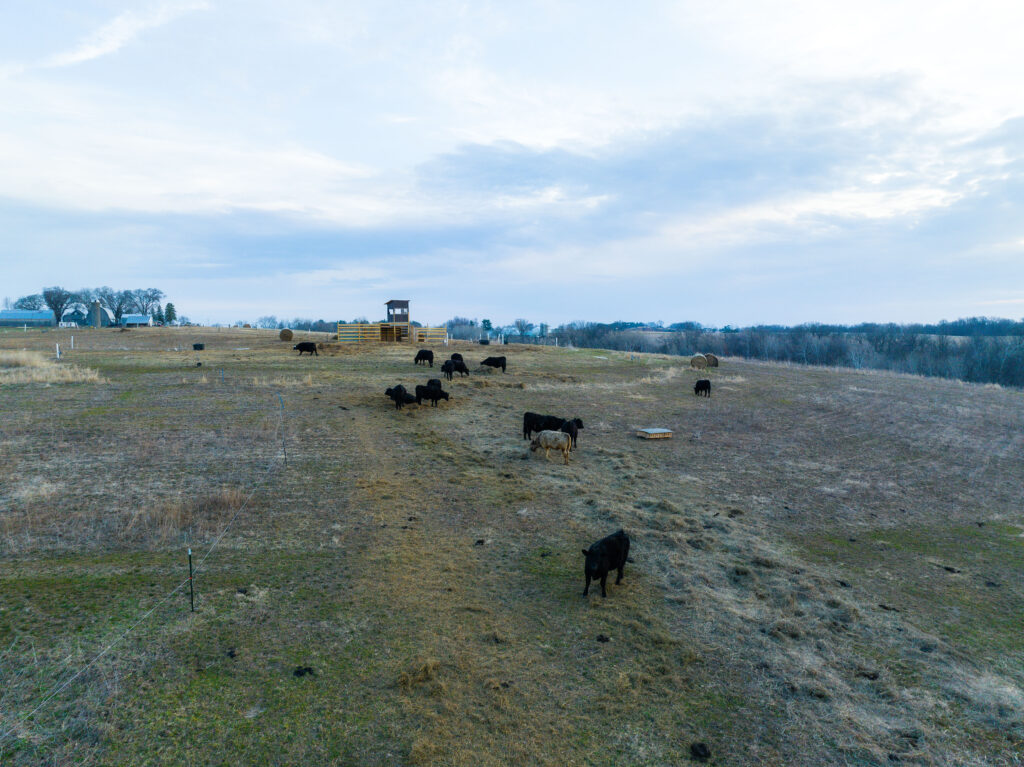Different bale grazing techniques for perennial and annual pastures can help optimize pasture diversity and nutrition
As regenerative and ecological agriculture continues to evolve, bale grazing has emerged as a powerful tool for improving soil health and productivity. At our farm, we’ve seen remarkable results from incorporating bale grazing into our systems. This not only enriches the soil with nutrients but also promotes natural reseeding and pasture diversity.
Bale Grazing on Perennial Pastures
Our approach to bale grazing varies depending on the type of field. For perennial pastures, I like to roll out first-crop grass haybales. These bales often contain a lot of seed heads, making them ideal for overseeding. While the quality of this hay might not be premium, the seeds in the bales contribute significantly to the rejuvenation of the pasture.
We integrate this practice strategically into our last fall and first spring grazing rotations. The first day, or morning, cattle graze the fresh paddock. The following day, or afternoon, they bale graze, benefiting from the rolled-out hay while trampling seeds into the soil. This method spreads out the nutrients and seeds while maintaining moderate impact to prevent compaction or excessive weed proliferation. What they don’t eat they will use as bedding. The longer rolled-out bales are left unconsumed, the more “waste” there will be.

First-crop bales also often have fewer thistle seed heads than later cuttings, reducing the risk of introducing undesirable weeds. Over time, I’ve learned to anticipate the types of weeds that might appear by observing the hay before purchase. For example, the timing of oat bales being harvested usually times up with thistles seeding out.
Traditional Bale Grazing on Annual Cover Crops
In contrast, on annual cover crop fields, we use traditional bale grazing. Here, bales remain stationary, and cattle feed directly from them. This approach concentrates the nutrient deposition, delivering a significant “nutrient dump” in targeted areas. Such concentrated organic matter and manure help restore soil fertility and improve the structure and water-holding capacity of the soil. We then spread out the leftover feed with pitchforks or the tractor in order to avoid the heavy pileup of residue.
Annual cover crop fields also serve as a buffer for experimenting with heavier cattle impact, knowing that the following crop rotation will address any challenges, such as compaction or weed pressure. We still attempt to stay away from stationary bale grazing until the ground is nice and frozen.
Bringing Nutrients to the Farm
One of the most valuable aspects of bale grazing is importing nutrients from other farms onto ours. Every bale of hay represents a bundle of organic material and minerals harvested elsewhere, which we now integrate into our land. This year, favorable hay prices have enabled us to increase the volume of hay we roll out, amplifying the benefits for our soil.
While rolling out hay may be 10-15 percent less efficient in terms of feed utilization compared to stationary bale grazing, the trade-off is well worth it. The distributed organic matter and nutrients, coupled with the overseeding effect of seed-laden bales, more than compensate for the slight decrease in feed efficiency.
The Weed Factor: Learning from Experience
Weeds, particularly thistles, are a common concern when introducing hay into pastures. Through trial and error, I’ve developed a slightly better eye for assessing hay quality (I have a long way to go) and understanding its potential impact on weed populations.
A heavy impact, such as excessive trampling or overstocking, can exacerbate weed problems. Therefore, keeping the cattle moving and managing impact around the weather are essential for a successful bale grazing system.
The Payoff: Healthier Pastures, Richer Soil
Bale grazing has significantly enhanced our pastures. We have never fertilized or brought in any other outside amendment, and our soil tests are starting to show the change. (We’re still not up to Gary Zimmer’s standards, though!)
By integrating cattle, hay and thoughtful management, we are mimicking natural processes that build soil fertility and promote pasture biodiversity. Whether rolling out hay on perennial pastures or concentrating nutrients on annual fields, this system aligns with the core principles of regenerative & ecological agriculture: improving soil health, maximizing resource efficiency, and creating a resilient farming ecosystem.
Bale grazing holds promise as a cost-effective and ecologically sound strategy for improving pasture quality while building healthier soils. With hay prices currently favorable, there’s never been a better time to roll out the bales — and reap the benefits.
Taylor Henry is the owner and CEO of Acres U.S.A.
















